
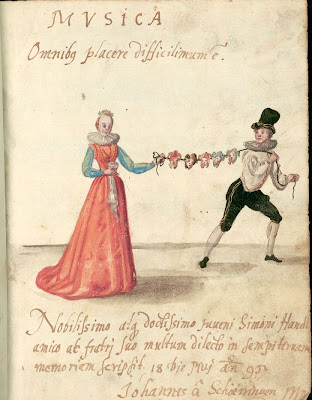



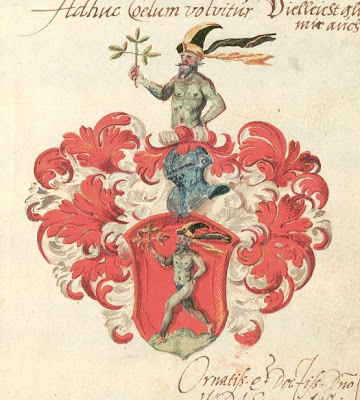


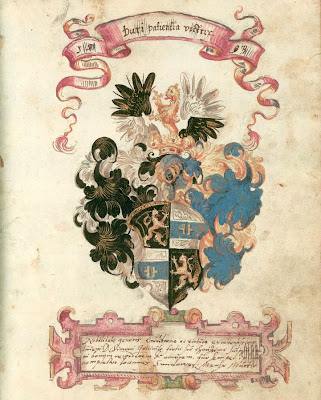

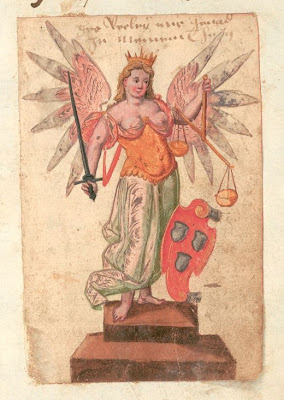


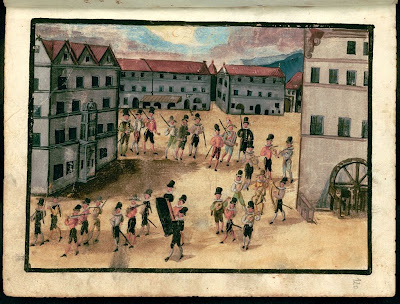




This book, owned by Simon Haendel, is at once both a stammbuch (friend's book) and a wappenbuch (armorial). The entries appear to have been compiled in the 1590s and the handwritten greetings that I read from a quick review (I've had these images for ages) are all in latin. The thing I remember that caught my eye was the vignette showing people being stuffed into what looks like a grinder. (4th from top) That is really weird. Unless it's meant to be a doll factory or??
The book is hosted by the Research Library in Olomouc, in the Moravian region of the Czech Republic. Hint: there are quite a few blank pages. Page across using the thumbnails rather than the links at the bottom of the page in order to see all the images (maybe I've posted half??).
Previously: Bavarian Wappenbuch; Stammbuch 1/2-way through post; from Holland: Liber Amicorum; Alba Amicorum. Also: Olomouc at wikipedia.
skip to main |
skip to sidebar


analytics
Books~~Illustrations~~Science~~History~~Visual Materia Obscura~~Eclectic Bookart.

Contact | Who?
Recommended Blogs
Blog Archives
Resource Sites
- digital nz
- library of congress
- british library
- library france
- library holland
- library spain
- library portugal
- european library
- library australia
- collections canada
- digital poland
- nypl digital
- botanicus digital
- v&a collections
- britmuseum prints
- smithsonian search
- smithsonian galaxy
- f.a.m.s.i.
- casglu'r tlysau
- rumsey collection
- manuscript catalogue
- digital scriptorium
- cesg manuscripts
- swiss manuscripts
- pecia mss blog
- digital book index
- rare book room
- online exhibitions
- primary sources
- worldcat search
- library directory
- digital librarian
- intute resources
- warburg institute
- lexilogos links
- digiwiki links
- museum blogs
- book arts web
- culture archive
- conservation articles
- art-history timeline
- visual arts
- arts journal
- artcyclopedia
- ukiyo-e
- calligraphy megapage
- penmanship
- woodblock
- coconino
- alchemy website
- health hist. img-banks
- health history links
- history network
- new advent


















9 comments :
Soulente Grene if...puple!
Charlton Heston would so fit in that hopper.
The "hopper" image appears to represent a myth/narrative, allegory or metaphor of rebirth; taken literally as recycling of bodies. Or it could depict a trick or con...
Old - used up - people are entered at the top of the hopper (an old woman is being hoisted in and further "material" is stored in sacks towards the rear). Children emerge from the bottom - where there is an appropriate birthing canal. Children at this time were considered miniature adults with miniature adult clothing, hence their doll-like appearance.
A transaction is taking place in the left foreground. However, it is slightly ambiguous as to who is the merchant (selling children). The man in the feathered hat and fine clothes (denoting a superior status) could be the buyer or the seller. He has something like a purse of money in his right hand. Probably he is the buyer as he doesn't seem to be a tradesperson (purveyor of children). However, the couple seem to be those most in need of children - unless they are selling their own children and are using the machine as a kind of cover or subterfuge. Note that the woman here is holding a gathered cloth above her stomach in the attitude of one about to or having just married - or indicating pregnancy.
An interesting image.
I really love your pictures!
Thanks very much David. I suppose there is the wider context also. These stammbuch were a tradition with students so a rebirth/renewal motif seems appropriate.
But it's difficult when there are heraldic emblems, conventional scenic pictures (apparently there was something of a tradition with fencing stammbuch also - see link below) plus the obvious mythic allegorical pictures (eg. fortuna) all combined in a single one-off book to which other students have made contributions.
And also: was it one artist? and were these miniatures made by request or by convention and if by request, was it by the owner of by the classmate contributor? They're certainly interesting historical artefacts.
Just by way of general background..
**“Dies schrieb Dir zur Erinnerung” - From Album Amicorum
to Autograph Book
**Alciato's Emblems and the Album Amicorum: A Brief Note on Examples in London, Moscow, and Oxford.
beautiful, as usual.
Intriguing, particularly with David's comments on the hopper as rebirth. The results do look miniaturized. This leads to the question of whether it would be as wise to put Charlton Heston in the hopper as might appear at first glance. What might he come out as... multiple midgets? Or would he be reborn as another species? Inquiring minds want to know and are afraid to find out.
I think most of the pictures are intended to have comedic nature- the pseudo heraldic material is downright funny. Usually heraldic devices reflect lineage or authorized arms - but a nude man bearing a clover? A man spreading a huge pair of chicken legs, over a field of chicks? 'Coupled' with the 'baby factory' - perhaps these students were making sexual jokes about themselves or their school.
These heraldic forms, although somewhat idiosyncratic, are similar to many other from around the same time period (check the wappenbuch link). I have an array of images on my desktop I've been meaning for the longest time to fashion into a post - they are by Jost Amman (d. 1590) who produced a kind of 'how to' treatise in relation to arms plates. I haven't gone into the background recently but I do recall that his diagrammatic models were very influential. They are also at times humorous (this may be a modern perspective however).
So I'm not disagreeing with the notion that this book has a humorous intent necessarily but what of the 'straight' miniatures - the fencing exercises and so forth - ?? It underlines the point that this book/these friendship/signatory-type books are historically more complex than first glance might suggest.
Post a Comment
Comments are all moderated so don't waste your time spamming: they will never show up.
If you include ANY links that aren't pertinent to the blog post or discussion they will be deleted and a rash will break out in your underwear.
Also: please play the ball and not the person.
Note: only a member of this blog may post a comment.